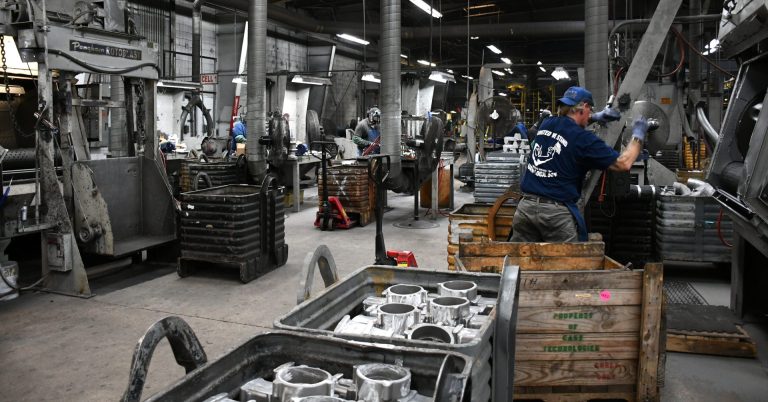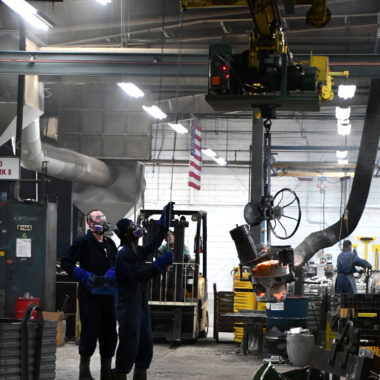Precision in Practice: The Art About Aluminum Casting
Precision in Practice: The Art About Aluminum Casting
Blog Article
Crafting Excellence: Exactly How to Achieve High-Quality Light Weight Aluminum Castings Whenever
In the realm of light weight aluminum spreading, the quest of perfection is a continual journey that needs a thorough technique and a keen understanding of the details involved. Accomplishing consistent high-grade aluminum castings requires a thorough understanding of the procedures, from choosing the proper alloy to performing precise mold designs and meticulously controlling casting criteria. However, real mastery exists in the capacity to implement these aspects seamlessly to create perfect spreadings each time. As we discover the intricacies of crafting perfection in light weight aluminum spreadings, discovering the essential techniques and techniques that bring about impressive outcomes becomes critical for those aiming for excellence in this customized field.
Understanding Light Weight Aluminum Spreading Processes
Aluminum casting processes, essential in the production market, involve the complex change of liquified light weight aluminum right into strong forms via a series of very carefully controlled actions. Comprehending these processes is paramount to accomplishing high-grade light weight aluminum spreadings continually - about aluminum casting. The primary approaches used in light weight aluminum casting are die spreading, sand casting, and investment casting

Each of these procedures has its benefits and is selected based on aspects like complexity, volume, and wanted surface of the light weight aluminum spreading. about aluminum casting. Understanding the intricacies of these techniques is crucial for manufacturers aiming to produce high-quality light weight aluminum castings continually
Picking the Right Aluminum Alloy
Picking the appropriate aluminum alloy is an important decision in the production of top notch aluminum castings. The selection of alloy dramatically impacts the properties and characteristics of the end product. Various light weight aluminum alloys supply differing degrees of toughness, rust resistance, machinability, and thermal conductivity. When choosing an aluminum alloy for spreading, it is vital to take into consideration the details demands of the application to ensure optimum efficiency.
One of the most commonly made use of aluminum alloys for spreading is A356 - about aluminum casting. For applications calling for high toughness, 7075 light weight aluminum alloy is a popular selection due to its extraordinary strength-to-weight ratio.
Along with mechanical buildings, considerations such as expense, schedule, and post-casting processes should also affect the selection of the best aluminum alloy. By very carefully evaluating these variables, suppliers can make sure the manufacturing of top quality light weight aluminum spreadings that meet the preferred requirements.
Applying Correct Mold And Mildew Design
Creating an effective mold layout is critical for guaranteeing the effective production of high-quality aluminum spreadings. Correct mold and mildew design plays a considerable role in accomplishing the preferred attributes of the end product. To implement a successful mold and mildew style, factors such as material circulation, cooling down prices, and part geometry need to be very carefully considered.
One secret element of mold and mildew layout is making sure correct filling and solidification of the light weight aluminum within the mold and mildew tooth cavity. This entails developing runner and gating systems that assist in smooth metal circulation and prevent defects such as air entrapment or incomplete dental filling. Additionally, integrating cooling networks right into the mold and mildew design helps manage solidification prices and reduce the danger of porosity or shrinkage problems.

Controlling Spreading Parameters

Making Certain Post-Casting High Quality Checks
To preserve the excellent quality of aluminum castings, comprehensive post-casting top quality checks are necessary. After the casting process is finished, it is critical to guarantee that the end products fulfill the desired specs and standards. One of the key high quality checks entails examining the surface finish of the castings to determine any flaws such as porosity, fractures, or surface irregularities. This aesthetic inspection is typically supplemented by non-destructive testing techniques like ultrasonic testing or color penetrant evaluation to spot internal problems that might jeopardize the integrity of the spreading.
Dimensional precision is an additional essential facet that must be validated throughout post-casting top quality checks. Measurements of vital measurements and tolerances should be required to confirm that the spreadings adapt the required specifications. Furthermore, mechanical homes such as hardness, tensile strength, and influence resistance may need to be reviewed my website through material screening to ensure that the spreadings possess the required toughness and sturdiness for their designated application.
Final Thought
To conclude, attaining top quality aluminum spreadings calls for a complete understanding of the spreading procedures, picking the ideal alloy, creating molds successfully, regulating casting specifications meticulously, and conducting post-casting high quality checks diligently. By adhering to these actions, suppliers can continually produce light weight aluminum spreadings that satisfy the highest possible requirements of top quality and performance.
Achieving regular top notch aluminum spreadings requires a thorough understanding of the processes, from choosing the appropriate alloy to implementing specific mold styles and thoroughly regulating spreading parameters. The key techniques utilized in light weight aluminum spreading are pass away casting, sand spreading, and financial investment casting.
Financial investment casting, also recognized as accuracy spreading, includes producing wax patterns that are coated in ceramic to form molds.Picking the ideal light weight aluminum alloy is an essential choice in the manufacturing of premium aluminum spreadings.Making sure precise control over casting specifications is vital for preserving uniformity and quality in aluminum casting manufacturing.
Report this page